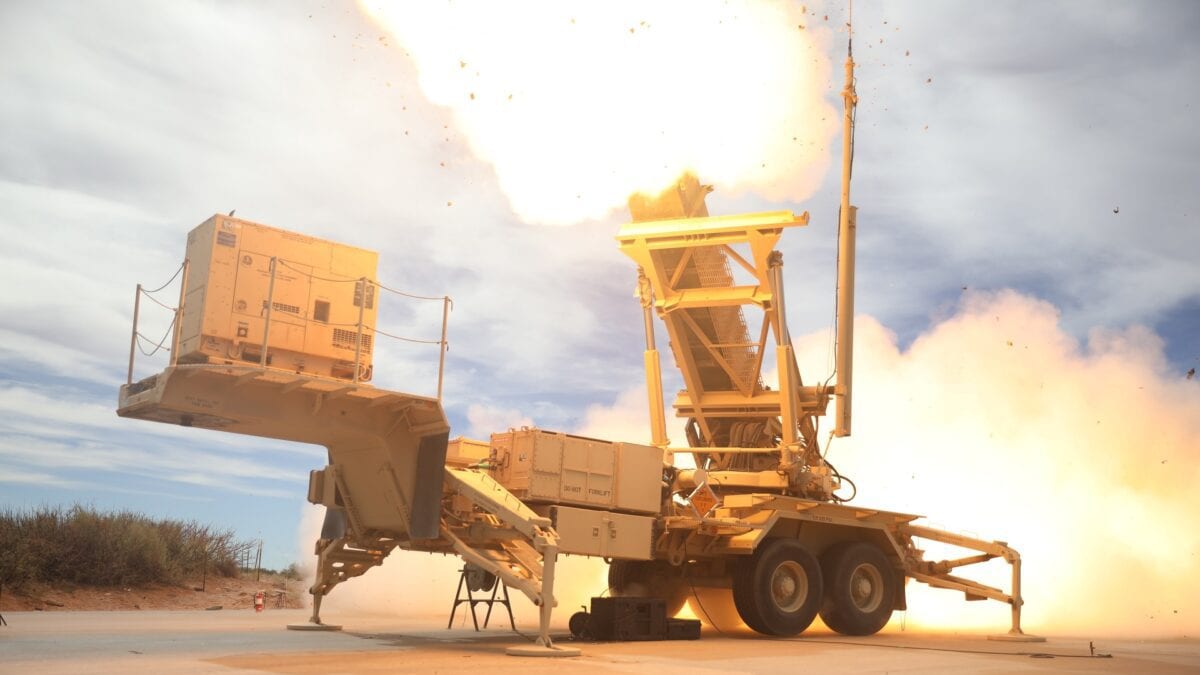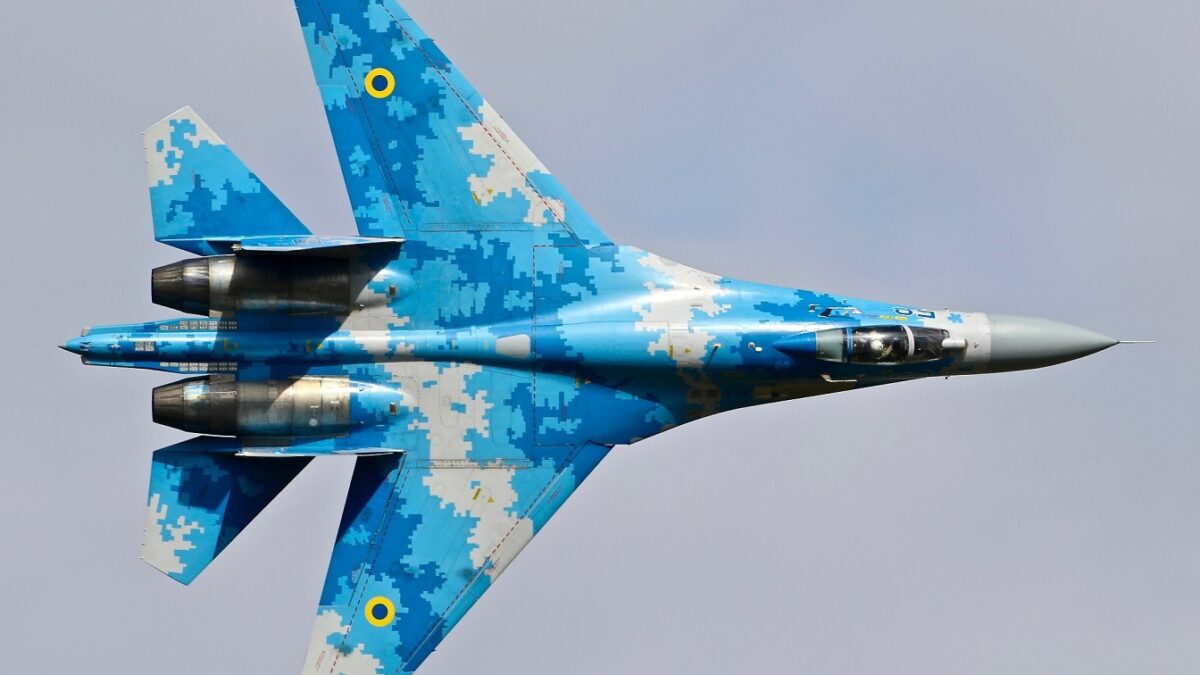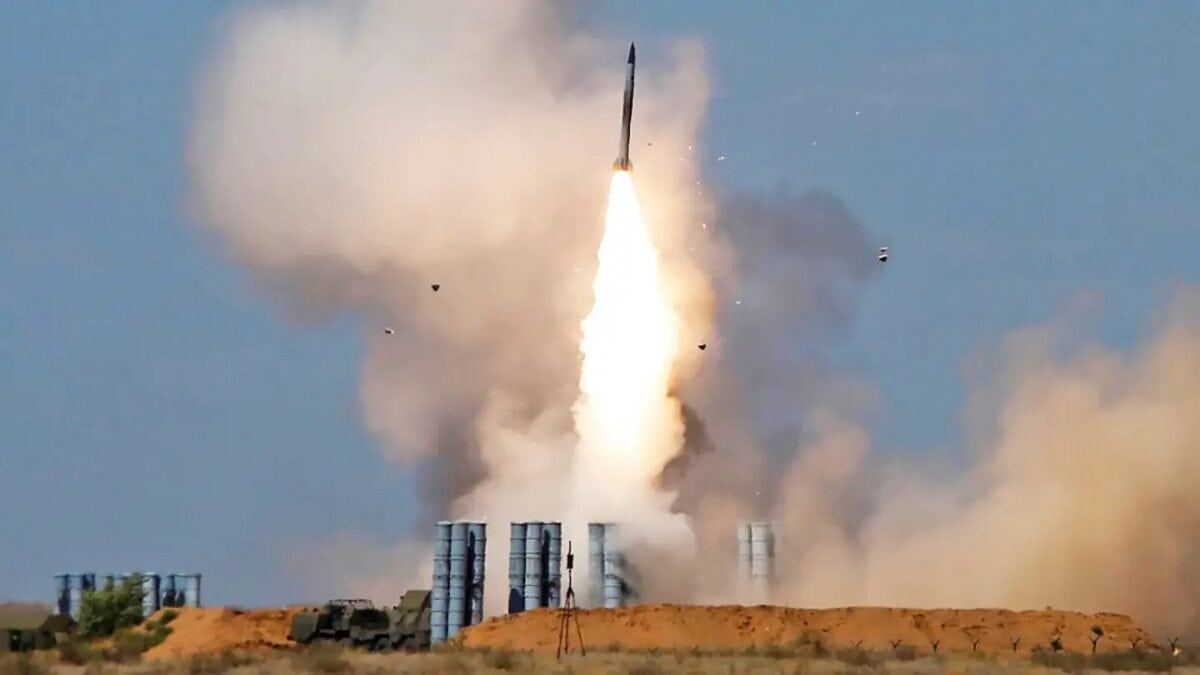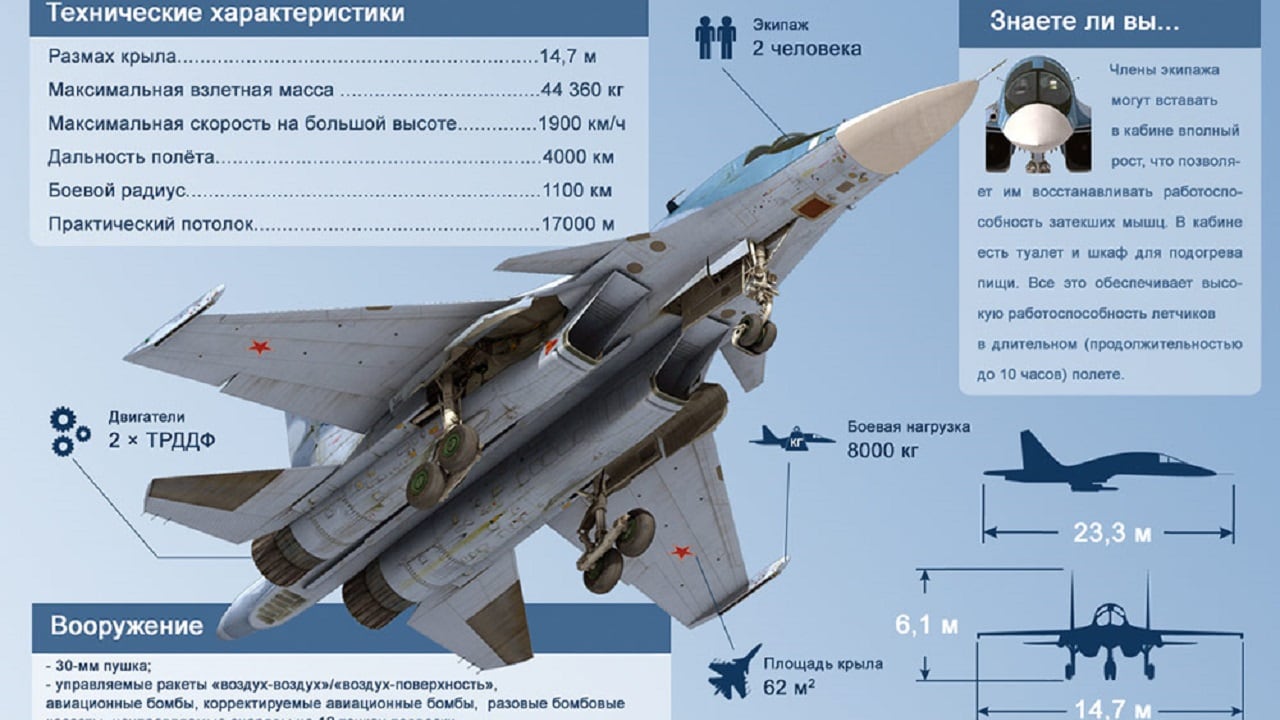By spring of 2023, Russia’s tactical aerospace force, the VKS, seemed to have improved on its initially disappointing performance in the war over Ukraine. After suffering heavy losses early in the conflict, VKS pilots were more successfully avoiding the engagement range of Ukraine’s surface-to-air missile batteries. They were doing so by confining their strikes to frontline targets or to border cities, firing from stand-off distance using arcing rockets or new glide bombs. Such tactics aren’t especially effective, but they are hard to counter.
The Russian Air Force lost a Su-34 Bomber, Su-35S fighter, and two Mi-8 helicopters today (one was a Mi-8MTPR-1 with a Rychag-AV) over Klintsy, Bryansk Oblast.https://t.co/oJuKhCBL7ahttps://t.co/rOnKarN115https://t.co/Uj0vcCIxxihttps://t.co/6iqkQRwNJkhttps://t.co/TQACvukEMY pic.twitter.com/Ts901HH5hI
— Rob Lee (@RALee85) May 13, 2023
The routine was dramatically disrupted on May 13, though, when two advanced Russian jet fighters and two helicopters on their way back from a bombing mission were destroyed in rapid succession. Even more shockingly, they were taken out over Russian airspace, in Bryansk oblast. This is not a place they expected to come under attack.
All of the losses were recorded on camera by stunned civilians. Reportedly none of the nine crew onboard these aircraft survived.
Losses of Value for the Russians
Russia’s losses on Saturday included a two-seat Su-34 Fullback fighter-bomber and a Su-35S Flanker-E multi-role fighter. These are two of the most modern aircraft types in VKS service, with powerful sensors, precision-guided weapons capability, and self-defense warning and jamming systems.
The Su-34 was seen falling rock-like to the ground near Istrovka and Starodub, 8 to 10 miles north of the Ukrainian border. The recording of the Su-35 shows it was already in flames before impact.
Two Russian Mil Mi-8 helicopters, a Sukhoi Su-34 fighter-bomber and a Sukhoi Su-35 fighter jet were shot down in Bryansk Oblast of Russia today, according to updated information.
The dark day of the Russian aviation indeed. https://t.co/WODSPtSj7N pic.twitter.com/4705ziY1Sw
— Status-6 (@Archer83Able) May 13, 2023
Twenty miles farther, both to the northeast and the northwest, two Mi-8 Hip multi-role helicopters came to their own fiery ends. A recording shows that one of the Mi-8s was struck head-on by a missile. It crashed into the outskirts of the city of Klintsy, injuring a civilian and damaging five houses.
At least one of the Mi-8s was among the 20 Mi-8MTPR-1 electronic warfare helicopters built with Rychag-AV jammers. This system can supposedly suppress up to eight air defense radars within a 93-mile radius to protect nearby combat aircraft.
Ukrainian Air Force spokesman Yuriy Ihnat denied the losses were inflicted by Ukraine’s military. The spokesman also claimed a third helicopter was lost and asserted Russia’s own air defenses had accidentally downed the aircraft.
Friendly fire isn’t implausible, given Russian jumpiness following raids by Ukrainian drones, but four friendly downings in a row would be quite a streak.
Given that Russia appears to have started to comb Bryansk oblast for infiltrators equipped with anti-air missiles, it seems possible that Ukraine managed to ambush the Russian aircraft using means it is choosing not to clarify.
Air Defense Ambush
Ground-based air defenses are often mistakenly thought of as static threat bubbles that encroaching aircraft must either circumnavigate, attack, or stealthily penetrate.
In reality, good air defense commanders continually redeploy mobile radars and launchers to dodge attacks and surprise attackers. When the attacking side’s mission planners begin complacently reusing the same timing and navigational routes, the defender might change their routines to spring an ambush.
This famously happened during NATO’s 1999 war in Kosovo. A Serbian air defense commander figured out the rough routines of F-117 stealth fighter operations and managed to shoot one down using an old S-125 system by deploying a targeting radar directly below its anticipated flight path.
But how did Ukraine shoot down aircraft over Russia? Bryansk oblast is right on the border, and the downed aircraft fell between 10 and 31 miles of Ukraine’s neighboring Chernihiv region.
Consider that Ukraine’s old but powerful S-300P air defense batteries have an engagement range of 56 miles. These batteries could have made the shot if positioned close enough. Further, Ukraine’s newly received Patriot PAC-2 air defense missiles have an engagement range of 93-100 miles, making crossborder shots more viable. Kyiv has received one battery each from the U.S. and Germany, with a few more expected, including one from the Netherlands.

Soldiers from 69th Air Defense Artillery Brigade conducted Patriot Missile live fire training, November 5, at McGregor Range Complex on Fort Bliss. The live fire exercise was conducted jointly with Air Defense counterparts from the Japanese Self-Defense Force. (U.S. Army Photo by Staff Sgt. Ian Vega-Cerezo)
That said, commanders are leery of pushing their most powerful air defenses close to enemy forces, multiplying risks of being detected and destroyed. Active air defense radars are indiscrete to an opponent’s sensors, and they are prone to being targeted. This happened when a Russian Kinzhal air-launched ballistic missile apparently targeted the radar emissions of a Patriot battery. The incoming Kinzhal, however, was downed by the battery.
Good air defense tactics often involve keeping some fire control radars off to prevent anti-radar missile attacks. Once enemy aircraft wander into the battery’s no-escape zone, the radar might be abruptly turned on to achieve surprise.
Ukraine could have quietly detached a few launchers and radars from a Patriot or S-300 battery and moved them closer to the Russian border with their systems powered down, leaving them invisible on the electromagnetic spectrum. Once long-distance area search radars — which can see far but aren’t precise enough for targeting — detected the Russian aircraft on the move, they could inform air defense crews where to cue the more focused arcs of their targeting radars.
At the optimal moment, the forward-deployed crew would activate the fire control radar, use the cue to rapidly acquire the Russian aircraft, and launch a missile at them within 30 to 60 seconds. The Russian pilots would have limited time to detect and react to the sudden threat. A Patriot battery could quickly shut off its own radar after firing, since PAC-2 missiles have built-in shorter-range radar seekers to guide themselves to the target.
Aircraft-Hunting Commandos?
An alternative ploy, which the Russians appear convinced of, involves Ukrainian special forces infiltrated into Bryansk and equipped with man-portable air defense missiles. Examples of these weapons include U.S.-supplied Stingers, British Starstreak, Polish Piorun, and Soviet-origin Igla-M missiles. As these are infrared, not radar-guided missiles (save for the laser-guided Starstreak), their launch would be harder to detect.
The operators and their handlers would first have to establish a clear picture of routine air operations and determine suitable sites to ambush low-flying aircraft returning to base. The separate teams could then stage multiple short-range ambushes in succession.
But choosing ambush sites would be very tricky due to the short-range (2-4 miles) and maximum altitude of portable missiles. The mission would be difficult to coordinate. Infiltrated operatives would also be at substantial risk so far into Russian soil.
An Air-to-Air Angle?
A third possibility is that Ukrainian fighters pulled off a surprise attack. But Ukrainian accounts insist that their pilots struggle to evade detection by Russia’s longer-range radars. Flying very low to mask against terrain helps delay detection, but not for long, considering rotating patrols by MiG-31 interceptors, Su-35 fighters, and A-50 airborne early warning planes with powerful downward-looking radars.
Perhaps an aerial ambush could exploit a gap in Russian radar coverage that results from terrain or the timing between patrols. Ukrainians might also possess new technical means to degrade or confuse Russian radars and attack the aircraft from a long distance.
Mena Adel, who writes on aviation exercises for Scramble magazine, suggested possible tactics:
“This requires the development of a deadly ambush plan, benefiting from prior reconnaissance, intelligence and co-ordinations to target the Russian planes, and the presence of a good distraction using electronic warfare means to open a corridor or gap used by the Ukrainian planes to infiltrate through at ultra-low altitude—which is something that Ukrainian pilots are currently specialists in, especially the northern fighter brigade in this region, including launching their missiles in a radius of 40-55 kilometers (25-34 miles).”
Adel pointed out that the Su-27 jets in Ukraine’s 39th Fighter Brigade can employ the R-27T and ET medium-range infrared-guided missiles, with a maximum range 31 or 56 miles. These are preferred over the radar-guided R-27R model because they’re fire-and-forget weapons, and they don’t set off a fighter’s Radar Warning Receiver.

Su-27. Image Credit: Creative Commons.
“Relying only on the Missile Approach Warning System to detect the missile’s final approach, the pilots will have only a few seconds to overcome their surprise and act properly, which could explain why they did not escape in this case,” Adel noted.
But launching an IR-guided missile from afar with the fighter’s radar off — or switched on only very briefly — and having the missile reach close enough to the targeted aircraft so that its infrared seeker locks on, would require impressive target cueing, and strong coordination with external assistance. Adel, however, wrote to me that in the 2018 Clear Skies exercise, American pilots reported their Ukrainian counterparts found unexpected ways to employ aging Soviet-era fighters against modernized F-15Cs.
Alternately, Ukraine could have somehow adapted its Soviet fighters to launch AIM-120 long-range missiles already in use by ground-based NASAMS launchers. However, jerry-rigging fire control of these sophisticated missiles would be highly challenging.
Implications
It remains to be seen whether this incident was a one-off, or whether Ukrainian forces have the means and intent to attempt additional cross-border aerial ambushes.
Russia’s military will be compelled to take measures protecting against further attacks, even if this reduces offensive output. Steps could include shifting aircraft to bases more distant from the border; ensuring flight paths are routinely switched up to avoid predictable routines; improving security around airbases; and deploying additional electronic warfare assets, defensive counter-air patrols, and sensors along the border. The VKS will also surely sustain efforts to hunt down Ukraine’s new Western air defenses, destruction of which would make for a propaganda victory if provable.
Kyiv, meanwhile, must decide on how it balances defensive and offensive roles for those same systems. A Patriot battery deployed closer to the frontline could inflict losses on expensive Russian warplanes that were relatively safe before, thus disrupting Russian use of air power during Ukraine’s counteroffensive.

S-300. Image Credit: Russian Ministry of Defense.
But such aggressive use would mean accepting greater risk of losing these highly valuable systems. It would also reduce coverage of the capital area and other major cities like Zaporizhzhia that are constantly under Russian drone and missile attacks.
There are no easy choices, but Saturday’s ambush suggests Kyiv has readied further tactical and technological ploys that it might seek to use during its impending counteroffensive.
That, or Russians air defenses really did shoot down four of their own aircraft.
Sébastien Roblin has written on the technical, historical and political aspects of international security and conflict for publications including 19FortyFive, Popular Mechanics, The National Interest, MSNBC, Forbes.com, Inside Unmanned Systems and War is Boring. He holds a Master’s degree from Georgetown University and served with the Peace Corps in China. You can follow his articles on Twitter.

